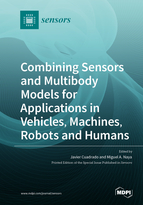Combining Sensors and Multibody Models for Applications in Vehicles, Machines, Robots and Humans
A special issue of Sensors (ISSN 1424-8220). This special issue belongs to the section "Electronic Sensors".
Deadline for manuscript submissions: closed (31 August 2021) | Viewed by 31343
Special Issue Editors
Interests: multibody system dynamics and applications to automotive, biomechanics, and machinery sectors
Interests: multibody system dynamics; vehicle dynamics; applications to the automotive sector
Special Issues, Collections and Topics in MDPI journals
Special Issue Information
Dear Colleagues,
The combination of physical sensors and computational models to provide additional information about system states, inputs, and/or parameters, in what is known as virtual sensoring, is becoming more and more popular in many sectors, such as the automotive, aeronautics, aerospatial, railway, machinery, robotics, and human biomechanics sectors. While, in many cases, control-oriented models, which are generally simple, are the best choice, multibody models, which can be much more detailed, may have application, for example during the design stage of a new product.
This Special Issue seeks works dealing with the many challenges that must be overcome when developing multibody-based virtual sensors. These challenges include the selection of the fusion algorithm and its parameters, the coupling or independence between the fusion algorithm and the multibody formulation, magnitudes to be estimated, the stability and accuracy of the adopted solution, optimization of the computational cost, real-time issues, and implementation on embedded hardware. We also welcome studies on the application of multibody-based virtual sensors to, for example, vehicles, heavy machinery, mobile or humanoid robots, assistive orthotic and prosthetic devices, or the measurement and analysis of human movement.
Prof. Dr. Javier Cuadrado
Prof. Dr. Miguel A. Naya
Guest Editors
Manuscript Submission Information
Manuscripts should be submitted online at www.mdpi.com by registering and logging in to this website. Once you are registered, click here to go to the submission form. Manuscripts can be submitted until the deadline. All submissions that pass pre-check are peer-reviewed. Accepted papers will be published continuously in the journal (as soon as accepted) and will be listed together on the special issue website. Research articles, review articles as well as short communications are invited. For planned papers, a title and short abstract (about 100 words) can be sent to the Editorial Office for announcement on this website.
Submitted manuscripts should not have been published previously, nor be under consideration for publication elsewhere (except conference proceedings papers). All manuscripts are thoroughly refereed through a single-blind peer-review process. A guide for authors and other relevant information for submission of manuscripts is available on the Instructions for Authors page. Sensors is an international peer-reviewed open access semimonthly journal published by MDPI.
Please visit the Instructions for Authors page before submitting a manuscript. The Article Processing Charge (APC) for publication in this open access journal is 2600 CHF (Swiss Francs). Submitted papers should be well formatted and use good English. Authors may use MDPI's English editing service prior to publication or during author revisions.
Keywords
- multibody dynamics
- virtual sensors
- fusion algorithms
- nonlinear filtering
- kalman filtering
- estimation/observation of states, inputs, and/or parameters
- real-time applications
- embedded hardware
- heterogeneous computing








